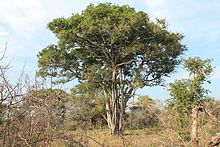
Podocarpus latifolius is a large evergreen tree up to 35 m high and 3 m trunk diameter, in the conifer family Podocarpaceae; it is the type species of the genus Podocarpus.

Curtisia dentata is a flowering tree from Southern Africa. It is the sole species in genus Curtisia, which was originally classed as a type of "dogwood" (Cornaceae), but is now placed in its own unique family Curtisiaceae.
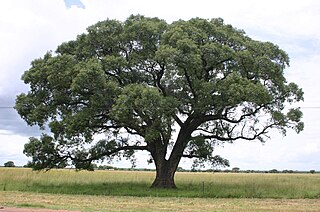
Sclerocarya birrea, commonly known as the marula, is a medium-sized deciduous fruit-bearing tree, indigenous to the miombo woodlands of Southern Africa, the Sudano-Sahelian range of West Africa, the savanna woodlands of East Africa and Madagascar.
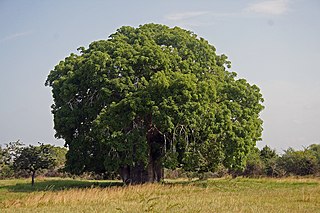
Adansonia is a genus made up of eight species of medium-to-large deciduous trees known as baobabs or adansonias. They are placed in the Malvaceae family, subfamily Bombacoideae. They are native to Madagascar, mainland Africa, and Australia. The trees have also been introduced to other regions such as Asia. A genomic and ecological analysis has suggested that the genus is Madagascan in origin.

Combretum imberbe is a characteristic and often impressive bushwillow species of the southern Afrotropics. The medium to large tree has a sparse, semi-deciduous canopy of grey-green leaves. The twigs and leaves are hairless as the name imberbe suggests. Its heartwood is dark brown, close-grained, and very hard and heavy, as suggested by its vernacular name. The durable hardtwood is much sought after in the woodcarving industry. The Hereros and Ovambos of Namibia attach special cultural and religious significance to the tree, as to them it is the great ancestor of all animals and people, which must be passed with respect.
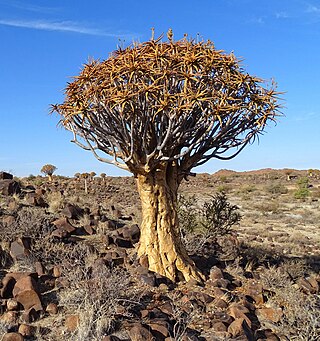
Aloidendron dichotomum, formerly Aloe dichotoma, the quiver tree or kokerboom, is a tall, branching species of succulent plant, indigenous to Southern Africa, specifically in the Northern Cape province of South Africa, and parts of Southern Namibia.

Ocotea bullata, is a species of flowering tree native to South Africa. It produces very fine and valuable timber which was formerly much sought after to make furniture. Due to over-exploitation it is now a protected species. Other names for it are Cape Walnut, Cape laurel, and laurel wood. The name "stinkwood" comes from a strong smell that is released when it is fresh felled.

Pterocarpus angolensis is a species of Pterocarpus native to southern Africa, in Angola, Mozambique, Namibia, South Africa, Eswatini, Tanzania, Democratic Republic of the Congo, Zimbabwe, and Zambia. It is a protected tree in South Africa. The name Kiaat, although Afrikaans, is sometimes used outside South Africa as well. In Zimbabwe, depending on what region you are in, it is known as Mukwa( which it is also called in Zambia) or Mubvamaropa.

Afrocarpus falcatus is a species of tree in the family Podocarpaceae. It is native to the montane forests of southern Africa, where it is distributed in Malawi, Mozambique, South Africa, and Eswatini. Common names include common yellowwood, bastard yellowwood, outeniqua yellowwood, African pine tree, weeping yew, , kalander, , and . It is widespread, in some areas abundant, and not considered threatened, but it is a protected tree in South Africa. It is grown as an ornamental tree, especially in South Africa, and occasionally abroad.
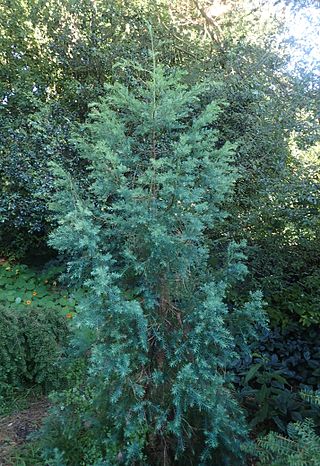
Widdringtonia schwarzii is a species of Widdringtonia native to South Africa, where it is endemic to the Baviaanskloof and Kouga Mountains west of Port Elizabeth in Eastern Cape Province; it occurs on dry rocky slopes and crags at 600–1,200 m altitude. It is threatened by habitat loss, particularly by wildfire. The Willowmore cypress is a protected tree in South Africa.

Millettia grandis is a species of plant in the family Fabaceae from South Africa. It is commonly called umzimbeet which is a name derived from the isiZulu name umSimbithwa.

Mimusops afra is a species of tree in family Sapotaceae. This tree is found in coastal dune vegetation in Southern Africa from the Eastern Cape, through KwaZulu-Natal to southern Mozambique.

Southern African Sand Forest is a sand forest, or a subtropical forest plant community of the tropical and subtropical dry broadleaf forests biome. It grows on ancient sand dunes in northern KwaZulu-Natal and southern Mozambique. In South Africa these forests are known simply as Sand Forest, while in Mozambique they are known as Licuati Forest. The Southern African sand forest is part of the Maputaland coastal forest mosaic ecoregion.

Northern Zanzibar–Inhambane coastal forest mosaic, also known as the Northern Swahili coastal forests and woodlands, is a tropical moist broadleaf forest ecoregion of coastal East Africa. The ecoregion includes a variety of habitats, including forest, savanna and swamps.

Afzelia quanzensis is a species of tree native to sub-Saharan Africa. It ranges from Somalia and Democratic Republic of the Congo to South Africa. It is a protected tree in South Africa.
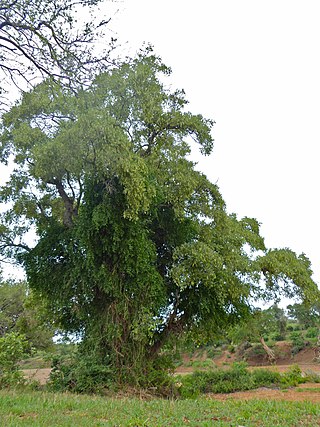
Philenoptera violacea known also as apple leaf or rain tree, Afrikaans: Appelblaar, Sotho: Mphata, Tsonga: Mohata, Zulu: Isihomohomo, IsiNdebele: Ichithamuzi, Idungamuzi, Iphanda) is a plant species in the legume family (Fabaceae).

Newtonia hildebrandtii, the Lebombo wattle, is a medium-sized tree native to eastern Africa. It is a protected tree in South Africa.

Combretum apiculatum is a species of tree in the family Combretaceae known by the common name red bushwillow. It is native to the mesic to semi-arid savanna regions of Africa, southwards of the equator.
Balanites angolensis, or Angolan green-thorn, is a species of tree from southern Africa, it is a member of the caltrop family, Zygophyllaceae.
Balanites pedicellaris, the small green-thorn or small torchwood is a small tree or shrub from Sub-Saharan Africa. It is a member of the caltrop family Zygophyllaceae.
